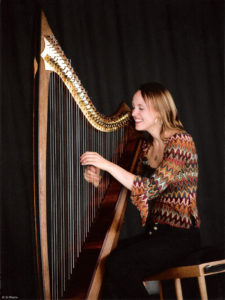Harriet Earis
https://soundcloud.com/miranda-whall/harriet-earis-porthpeiran-final-mix
Harriet studied classical harp reaching Grade 8 with Distinction. She has a degree in Medieval Celtic Studies from Trinity College, Cambridge and now specialises in the Celtic harp.
In 2005 she was one of a handful of young musicians across the UK selected to be on Yehudi Menuhin’s “Live Music Now” scheme which led to over 150 solo concerts at community venues around Britain and an invitation to meet the Queen in Buckingham Palace. In 2007 she won the Open Stage competition at the Celtic Connections festival in Glasgow, chosen from 82 acts competing for the title. She has toured as a soloist in 25 different states of the USA as part of the Irish Variety Show and gives regular solo concerts across Europe, including frequent tours of Germany, Italy, Holland and France. With her trio of harp, bass and drums, “The Harriet Earis Trio”, she has represented Wales both at “Celtic Connections” and at the Festival Interceltique in Lorient, Brittany in 2008.
She has made numerous recordings including two trio albums where she mixes Celtic harp music with jazz. Her trio is currently touring the UK with ex-Riverdance tap dancer Lee Payne with a show called “Harp and Tap”.
Harriet has played solo in the Royal Albert Hall and the O2 Arena in London to over 25,000 people as part of “Young Voices” 2007. When she is not touring she teaches the harp and gives harp workshops from her home near Aberystwyth.
I asked Harriet
What aspect of the landscape inspired your composition
How did you approach writing the composition
How did you approach playing the composition
How did you approach recording the composition
What technical, structural, formal aspects of the composition are specifically interesting
She replied:
Even though I live in the midst of the Cambrian Mountains, I felt that it was important to visit the project area to give some authenticity to the music. I drove up into the hills near Cwmystwyth on an incredibly windy day (16th Oct 2017) and walked around for the day using my phone to take photos and video whilst humming any tunes that came to me into a voice recorder. Certain repetitive melodic motifs came into my head which became the basis for each section of the final piece.
The wind was so strong that day that often I could barely make myself heard on my recordings over the gusts – it was even so stormy that by the time I left a tree had fallen over the road blocking my route home past Pwllpeiran!
This weather had a huge influence on the composition. It was utterly exhilarating and lent a lot of rhythm and energy to the final composition which it wouldn’t have had on a calmer day. As I knew that Miranda had been “crawling” through this landscape I also deliberately took close-up photos of bits of barbed wire, fallen logs, thistles and reeds, forcing myself to look at little details in the landscape that I might normally have ignored. The faster, more intricate parts of the composition were directly influenced by looking closely at the tangled vegetation and complex, ground-level view.
Back home, I restricted myself to the melodies that I had hummed on location, first finding the tunes on the Celtic harp and then improvising over them repeatedly whilst imagining the landscape I had just experienced. I recorded each improvisation and listened back to see what worked, gradually settling on a form. The final recording was done using 2 channels (a DI and a microphone) from the Celtic harp into my laptop and was an edit of two improvisations cut and pasted together using Digital Performer.
I was aiming to have music containing multiple moods to fit the rapid, visually-confusing micro-footage Miranda had shown me. I decided at home to add a slapped bass effect at the start (damping the strings quickly after playing) – quite an unusual technique on harp – to give some rhythmic forward movement and a feeling of travelling. This ‘drone’ helped to knit the different melodic motifs together over a regular pulse from the start and gave the piece a bit more structure. The slower expansive sections in the middle in free timing were my attempt to reflect the wide-open vistas of distant mountains that kept appearing when the clouds parted and the sun came out, whilst the chaotic irregularity of those buffeting gale-force winds from every direction gave me the idea of changing time signatures, alternating bars of 6/8 with bars of 2/4, in the last, faster section of the piece.
